In Episode #78, Dr. Jill Interviews Beth O’Hara on Mold and MCAS. Why is mold toxicity such a big trigger of Mast Cell Activation Syndrome? Learn about Precision Mold Detox in Mast Cell Activation Syndrome and Sensitivities.
Key Points:
- Why is mold toxicity such a big trigger of Mast Cell Activation Syndrome?
- Why do so many sensitive people often struggle to detox and get so many reactions?
- What are the 2 most important first steps for sensitive people to take before detoxing mold?
- What is the research literature showing as the most effective mycotoxin binders?
- What is the research literature showing about Phase II detoxification pathways and mycotoxins?
Links Discussed
MC-360 Precision Mold Master Class
Related Posts
The Podcast
The Video
The Transcript
Dr. Jill 00:13
Hey, everybody! It's been just a little while; I've been traveling. I was just in Orlando at Dave Asprey's upgraded biohacking Bulletproof conference. What a great time it was just to be with colleagues and like-minded people and see all kinds of cool things. But we've been away from podcasting and doing these videos for a couple of weeks. So it is good to be back.
Dr. Jill 00:34
I'm here with a guest today that we've had before. I am so excited to have her again and to tell you about one of her new courses and some of the work she's doing to help all of you with mold and mast cell activation. So stay tuned for that. And I will formally introduce Beth O'Hara in just a moment, but before I do just a little housekeeping. You can find all of my YouTube videos on YouTube—my channel—just under my name: Jill Carnahan, MD.
Dr. Jill 00:59
If you haven't heard, we're now live on Spotify, Stitcher, and iTunes. Anywhere you can listen to your podcast, you can find my podcast. It would be the audio version of these videos, so you can listen at your leisure when you're hiking, biking, walking, or in the car. It's a little easier than navigating the YouTube site, so hopefully it'll be a great resource for you. This one will also be live there shortly. So you can find those all there. If you want resources just from my website, you can find me at jillcarnahan.com—my main website with all kinds of free resources—ten years of blogs. So there are literally thousands of articles there, all free. And then you can also find any of the products at drjillhealth.com.
Dr. Jill 01:43
Today I am just absolutely excited to welcome guest Beth O'Hara. She's a Functional Naturopath specializing in complex chronic cases of mast cell activation syndrome (MCAS), histamine intolerance, and mold toxicity.
Dr. Jill 01:56
We share a similar journey and we'll give you a little refresher if you didn't hear her first interview about her own journey. And it's a little bit parallel to my own. Often, the greatest learning comes through our own experiences. She's the founder and owner of Mast Cell 360, a functional naturopathic practice designed to look at all factors surrounding health conditions: genetic, epigenetic, biochemical, physiological, environmental, and emotional. And this is needed now more than ever, because there are so many environmental toxins and loads—and we'll talk about that today—that are just weighing down our system. And it's almost like we're under this weight and we can't get out. I think it's a piece of the puzzle with the recent pandemic and why things are so bad is because our environmental toxic load is weakening our immune system. She's got lots of credentials. She's designed: Mast Cell 360, a website, a course. And we're going to talk about her new course today, too. So without further ado, welcome, Beth, to the podcast.
Beth O'Hara 02:58
Thank you so much, Dr. Jill. I'm just really thrilled to be back with you and I love everything that you're doing!
Dr. Jill 03:04
Thank you. And we align so well. Like I said, we both have our own journeys and also just a passion for helping. I'm sure like you—we both—a lot of people are getting stuck in the system and not getting help. And they're either told they're crazy or told that their labs are normal, because docs don't know what to check. But I know, like you, I see patients all the time that have been to a lot of doctors. They've been told it's all in their mind, and you and I know this isn't always true. In fact, most of the time, it's not true. And when we look at the deep level of labs, a lot of times there's this puzzle with histamine intolerance. Before we go into mold and histamine intolerance and how these all connect, do you want to share just a little bit of your story and how you got into this?
Beth O'Hara 03:46
Sure. When I was a child, we moved out to the country. My parents bought this old farmhouse—I was really into Laura Ingalls Wilder at the time—it seemed like this big adventure. We had a couple of acres. But what we didn't know back then was that that house was so full of toxic mold. And mold wasn't an epidemic like it is now. Some people got mold toxicity, but it wasn't that kind of problem that we're having now. We didn't have routers back then and, you know, wi-fi devices or anything like that—that's increasing the growth of mold, but there was just so much. And as a child, my health started going downhill a couple of years after we moved there. And I played outside all the time, so I was bitten by ticks continually.
Beth O'Hara 04:33
By the time I was in high school, I was crashing pretty badly with my health. I was having a hard time getting up in the mornings. I had a lot of chronic pain. I'd had a head injury as a child, which didn't help, and I started to develop cervical cranial instability and mast cell activation. So by the time I was 12 [years old], I was on more medications than both my parents put together. So I would break out head to toe in chronic hives and would scratch my skin until I bled. My eyes were always itching so badly that I couldn't keep makeup on—when I was later a teenager—because I was just constantly rubbing my eyes. But I pushed through. I went to college. And I'm, like you, an overachiever and that “go, go, go,” and I have so much I want to do. And in college, I was working three jobs—I was teaching.
Beth O'Hara 05:31
I was teaching at a technical school where you had to have a master's, and I didn't have a bachelor's yet and [was] just doing a lot of stuff. I was taking graduate courses and burning the candle at both ends. And I completely crashed out [in] my junior year of college. I couldn't hardly move. I couldn't get out of bed before 12 o'clock. I had multiple scholarship offers to medical school and I had to turn them all down. And it was still probably one of the most devastating things that ever happened, because that was my dream. When I was six, I was in a little recital and decided, at that age, I was going to be a doctor. And so I had to figure out what in the world else I was going to do. I barely finished out my bachelor's. I took the minimal number of credits. I had to take the easiest classes just so I could finish.
Beth O'Hara 06:20
I wanted to go into neurology. Instead of going into neurology, I became a chronically ill patient and did the rounds, and I exhausted Western medicine. I tried every medication. Most of them made me worse. I kept getting more sensitive as I went along, and then I started holistic medicine. And back then, functional medicine was still early. And I started and I found functional medicine. I mean, when I say I tried everything—I tried homeopathy, I did psychotherapy because so many people told me I was making this up. And I did ten years of therapy. I did shamonic work—I did anything I could possibly do and I just kept getting worse.
Beth O'Hara 07:07
By the time I was in my late twenties, I was walking with a cane, and my friends were going out dancing, and I could barely—I would hold my bladder just so I didn't have to get up and hobble to the bathroom because it was just like walking on glass in every joint. It was just horrible pain. And the sensitivities kept getting worse to [the point] where, in my thirties, I couldn't even do a sprinkle of quercetin, it would make me inflamed, or cumin would make me inflamed. Things like GABA would make me anxious. I was having these paradoxical experiences and didn't know about nervous system dysregulation and how mycotoxins, Lyme, Bartonella, and all these things cause nervous system dysregulation. But we figured out the Lyme, the Bartonella [and] the Babesia first. I couldn't tolerate any treatments. I couldn't take anything. And when I started reacting to homeopathics, it was like, “This makes no sense at all!” But later, I landed on the mold toxicity [topic]. I was like: “This—this is it!” And at that point, I had seen 75 practitioners and totaled up that I had spent over $350,000 trying to get my health back.
Beth O'Hara 08:24
Thank God for my husband, who took care of me because I couldn't hardly work. I was barely functioning. But I crawled out of that hole, and the mold toxicity and the nervous system dysregulation were the huge pieces. And I was one of the fortunate people that fall around 30% [or] 40%. My Lyme cleared spontaneously once the mold toxicity was cleared up. But the nervous system dysregulation had to get addressed first. I'd had a lot of traumas. I've had this head injury—some bad car accidents. And then all [those] biochemical signaling pieces that were going on—the cervical cranial issues, the vagal pressure. So that was a big part of the healing as well was to calm my nervous system. And that opened up the door to being able to do the protocols and take the supplements to get well. And I bring that in because people so often underestimate it, but I find—and I specialize in super sensitive people now—it's 50% of the healing process at a minimum. And for some people with a lot of trauma, it might be 60% or 70%. It's as important as all these supplements that we're trying to do.
Dr. Jill 09:38
Beth, thank you for sharing. I remember the first time we talked and you shared, and you shared even more today. It so resonates. Number one, I think everybody listening who's had any experience with mold or MCAS is just listening and having such great compassion for you, because we all know where you've been. Maybe not even to the extreme, but it's unbelievable. And what a testimony for you to have gone through this. And I'll tell you again, you know this, I mentioned it earlier, but when we walk through this journey, there are these bits and pieces of knowledge that we could never get in a textbook or in a lecture hall. I have this all the time where I have this intuitive sense that, like, “I know what that is” or I recognize something. And there's no textbook that would've ever told me that. It's my own journey that taught me the most—way more than any medical education. So I'm so sorry you had to suffer. But like me, because of our suffering, we bring a different level of understanding to this field for sure.
Dr. Jill 10:32
As you were talking, a couple of things came to mind. First of all, histamine is this crazy thing. And I wanted to tell you all, we all are talking about histamine as this danger signal, and it's overreactive, and it's related to mast cells. And mast cells are these primordial cells that protect us, and they're doing their job. So they just get kind of angry and irritated, like if you poke a bear that's trying to hibernate, and then they get overactive and they throw out literally hundreds, maybe even thousands, of chemicals; prostaglandins and histamine. And histamine is the one we talk about.
Dr. Jill 11:00
What I wanted to mention as part of your story was that I was a perfectionist. I was a high achiever. You're highly intelligent. I can say that about you. And guess what? Histamine is actually highly associated with IQ and motivation—so there's this good side like everything. Histamine can be really beautiful. And a lot of the patients—and you and I both share this too—we actually genetically produce a lot of histamine. And there were good things too that are part of our lives because it allowed us to be productive and ambitious, very intellectual [and] curious—those things. But as [with] any curve, too much of a good thing is a bad thing. So I just want to mention that because histamine is good: it keeps us alert, it keeps us focused, it's motivational. But too much is a bad thing. And we often see this pattern because the higher histamine people tend to be the higher achievers because of that histamine load. So it's very interesting.
Dr. Jill 11:48
Now, a third thing you mentioned that I wanted to comment on was your concussion. So I've talked to my friend, the Broncos' neurosurgeon, Dr. Chad Prusmack, many times on this. And he's a concussion expert. He's a neurosurgeon. And he has looked at the data. He knows functional medicine. And he said: “Jill, a concussion by itself is very much not an issue. It's a concussion plus toxin or infection.” And the literature supports this. So what happens is when you have a head injury, if you had no infection like Lyme or co-infections and no mold exposure, you might never notice. You might not have residual issues. But when you have a concussion on top of a moldy situation or mast cell activation or Lyme, Bartonella, Babesia—these co-infections—that's when it becomes more chronic or more of a problem. And it's also similar to the layered—what you talked about.
Dr. Jill 12:39
A similar journey for me is the trauma. Old trauma gets compounded when we get mold exposure. So back to your original point, and then I'll let you explain some of this. There's always a traumatic component to mold and Lyme too—I would say 100% of my patients, even if they're not super sensitive, like the ones that you see. There's a piece of the puzzle that's addressing old trauma that gets them well. And that's because limbic activation can happen with a physical substance like a toxin. It can happen with an infectious thing like babesia or Bartonella, Lyme, Epstein-Barr, COVID—any of these things. And it can also happen with trauma. And the body doesn't differentiate. That limbic system activates on all levels for any of these things, and then starts this loop. But they tend to compound on one another, don't they?
Beth O'Hara 13:25
It absolutely does. We can be going through our lives just fine. We know that people often have these multiple mold exposures. So for most people that end up chronically ill from mold, it's not like it's just one event. For the majority of them, they've had repeated exposures, but it was just under that threshold and they were doing fine. But then something crosses the threshold with either toxins like mold and chemical toxins, pathogens, stress or injury and pushes it into that cell danger response. And in that cell danger response, it triggers these old layers of trauma to the surface. And that's exactly what you're talking about. And so we've got to peel those back. So it's not that it's in our heads and it's not that we're making it up. And it's not that this is psychological. But it is that the healing is partly an emotional, spiritual healing as well. And that's why I called it Mast Cell 360. And I know that's the work you do too. We've got to look at the whole person. We can't just be going, “Okay, let's fix biochemistry,” because everything is connected.
Beth O'Hara 14:32
When I'm teaching at conferences, I have a slide I like to use. It looks like a buckyball—like a soccer ball with tons of facets—it has all these points. And then I lay out on here: we've got mold toxicity; we've got lyme; we've got structural issues; we've got craniosacral fluid issues; we've got all these biochemistry and blood issues and heme issues. But then we have to also lay out here: we've got emotional and spiritual and structural… And if we start to impact one area, it reverberates through the whole system. So if we start to impact on the spiritual/emotional as well, it reverberates through. And we have to have this supportive environment to heal. And so many people aren't getting that experience. They're getting this just hard-edged, aggressive, “You do this” or, you know, “That's it! I can't help you if you can't take six capsules of this” thing. But we have to feel safe to heal as well. We've got to feel safe with our healers, and we've got to feel safe within ourselves and develop that sense of safety. And as much as I never would've chosen to have gone through what I went through, and I know you wouldn't have either, the healing that I did has brought me to a place I don't think I ever could have gotten to otherwise.
Dr. Jill 15:58
I could not agree more. I so often like these gifts—now that I look back—the cancer, the Crohn's, the mold, all this stuff I've been through, each one of them was this massive gift. It didn't feel like it at the time. But like I said, the training I got in the school of suffering is really, really good—way better than medical training! So a couple of questions—it's so fun to listen because I think of all kinds of great questions—first of all, I want to talk about the mold and mast cell trigger next. But before we do, I want to talk about why are some people in an environment [where] they might have Lyme and they don't know it, they might have a mold exposure, and then as they start to figure out this threshold—I think of it as a bucket [that] starts to fill up with toxic loader infections and it starts to pour over the top—and at some point, they start to be symptomatic. And they start to wonder: “What's going on? I'm not well.” But why is it that as we start to treat them, whether they're super sensitive or moderately sensitive, they sometimes become more sensitized before they get better? It's like the term ‘unmasking.' You've probably used that as well. Can you talk just a little about what is unmasking? And then let's go into your question about: what would you do first for the really sensitive people before detoxing mold? So unmasking, and then what are the very first steps for someone who's super sensitive?
Beth O'Hara 17:13
So unmasking is not a term that I've actually heard.
Dr. Jill 17:18
Okay. So again, this is on the mold circles. I always learn from you. So unmasking is that term—basically when we first start to detox someone who has mold, say they're immersed in this home and the home is full of mold and they don't feel great, but they're not walking in the laundry detergent aisle and having red bloodshot eyes and itching. They're kind of okay. But as we start to do the detox process, they actually become more sensitive to chemicals and more sensitive to mold. And they're like: “I'm getting worse. What's going on?” So I've heard that term ‘unmasking' for that. And I know you know that—just maybe the terms we use—what would you say to that? What's happening? What would you do? How would you reassure people?
Beth O'Hara 17:58
Yes, that makes complete sense to me. I think of it as like, layers will surface. So part of what I think is happening there is twofold: one is [that] we're pulling maybe too many toxins too fast. And we have to really watch that, and particularly aggressive detox protocols. And there are some people who can absolutely take any amount of binders, any amount of other agents, any amount of glutathione, and they're perfectly fine. [Those] aren't the people that make it into my clinic, so those aren't the people that I serve the best. I serve well the people who are struggling with glutathione—they're struggling with taking a whole capsule of charcoal or chlorella or clay and zeolite—these are setting them back. So we have to remember that these agents will draw toxins out of the tissues. And then we've got these toxins circulating and we have to clear them through bowel movements, through stool, through sweating, through lymph drainage. And there's a threshold for everybody.
Beth O'Hara 18:57
There's a rate of excretion and a rate of pulling into the bloodstream. So if that rate of pulling the toxins out of the tissue exceeds what we can excrete, we're going to have more toxins in the bloodstream than we can handle. And that's the whole premise of Neil Nathan's book, Toxic. We don't want to get to that toxic state. So then we're going to start having more sensitivities. That's one element of it. Another element is [that] as we're pulling these things out, they're going to trigger the nervous system. And this whole sensitivity thing that so many people are struggling with—I can tell you, even from when I started working with people one-on-one, about 12 years ago, this has gotten much worse. And the people that I talked to, like you, have been working with people for 20 [to] 30 years—they're seeing this get compounded and worse over time.
Dr. Jill 19:52
I agree. And I just want to say this is exponentially—it was like 10 years ago and then it changed, five years ago and now it's year by year—it is exponentially the types of patients every year, every month that I see. Again, I don't want to interrupt you. I just thought this is so important. That complexity and toxic load is getting worse, right?
Beth O'Hara 20:14
Yes. And especially in this past year and a half. And I think there are other factors with that. I don't want to go too far on a tangent. But the other piece is [that] our mast cells, our vagal nerve, and our limbic system work as an axis, as our sensing and defending system. And when I went through my graduate classes and did all the anatomy and physiology, and when I talk to people even now, I get medical students who come in and tell me, “We're not being taught about mast cells. We're not being taught about how the nervous system, the immune system, and the hormone system, the endocrine system are all actually interlinked.”
Dr. Jill 20:57
There's a term now, it should be in medicine—like, at the forefront—’neuro-immuno-endocrinology.’ This is a science. And yet, like you said—for sure my education and these students that are coming out now—there is not a lot of understanding around this, is there?
Beth O'Hara 21:12
No. It's a whole specialty. That's what I specialized in in my master's research. And what I've continued to really dive deeply into is how these things are linked. What I find so fascinating is [that] there are mast cells at every nerve ending. And the mast cells have receptors for the neurotransmitters and the neuropeptides being released by the nerve endings. And the nerve endings have receptors for the mast cell mediators. And there's this continual feedback loop.
Beth O'Hara 21:44
There are also mast cells in the limbic system, in the brain. So this is part of how they're working together. And I think of them like the guards of the castle gate—they've got their arms linked—they're there to protect us. And as you called them, primordial cells, they've been with not just humans, but all mammals, all animals for all these millennia, millennia, and millennia. And they're sensing everything. That's why they've got these hundreds of receptors to sense chemicals, to sense mold, viruses, bacteria. They sense stress chemicals, they sense foods, they sense anything in the body. They line all of our blood vessels and sense everything going through the bloodstream. And so when we're pulling more mold toxins into the bloodstream, it's going to trigger more of those mast cells. Those mast cells are going to sound the alarm to the nervous system, to the vagal nerve—which is super complex, and now we're calling it the polyvagal system because it's not just one nerve—and to the limbic system. And they're in control of sensitivities, those three areas. So we're pulling too many toxins too fast. That's going to dial all of that up. And that's why we really work on calming the nervous system.
Beth O'Hara 23:02
So I talk about, “We have to go through and do detox prep before we can detoxify.” And I was just meeting with somebody yesterday. He's a CEO. He's, like, gung-ho; he wants to get on it. And I had scheduled him ten weeks out. And then I see him on my schedule. And I'm like, “We just met three weeks ago.” Well, he'd gotten his real-time mycotoxin test back, and he wanted to get on those binders. And I'm like, “Well, how's the nervous system work going? Have you started the mast cell stabilizing supplements? Where are you with that?” And he hadn't gotten there [yet]. [So I said,] “I'm sorry, I'm not going to give you binders today, because if I do, you're likely going to be five more steps back when you get started.”
Dr. Jill 23:44
And I just want to comment. I'm going to be so stereotypical, but it's so classic. Those men, they're like: “Give it to me. Let's do this, let's hit this mold! Let's kill it! Let's do it!” And again, I was like that too.
Beth O'Hara 23:56
I was too. Yes.
Dr. Jill 23:57
So it's kind of like that energy of like, “Come on, let's just get this done! Let's get to the program.” But what you're saying is that it can really be harmful. This is so important if you're listening because Herxheimer reactions have been around [for] a while. If you've never heard that term, that means, say we're treating Lyme or Epstein-Barr or some chronic infection, and we give you the medications or the herbs too quickly, the dead debris that we're dealing with in the body overwhelms the detox system, the capacity, and so you have symptoms. A lot of docs are just like, “Oh, it's fine. It's just a herx.” You and I, we're like, “No, no, no. That means we're overloading the pathways: the lymphatics, the lungs, the kidneys, the stool, and the gut. And we need to pull back.” And this is very similar. It's not like a killing of anything, but it's an elimination process. And again, as a naturopathic functional practitioner, you're even more attuned to those—aren't they called the **‘humunctins’? Or there's a term for that.
Beth O'Hara 24:50
Yes. You've got to drain. You've got to be able to drain out before you add more in. And so I tell people that if you are flaring already when you come in, and you're up here—so for the people who don't have the visual, you're up six feet in your flare—and you're flaring up and down, and then we're going to add detox agents, which is going to give you more ups and downs, you're not going to like me. You're not going to like your life. And we don't want to do that. We want to bring this flare down. Not that we can get rid of it right now, but let's calm it down and let's bring it down like a good two feet so that when you're starting the detox, then your ups and downs are much more comfortable and you can get through this. But I think I lost about three years doing this aggressive trying-too-hard, and that's where I learned my lesson the hard, hard way.
Dr. Jill 25:49
Me too. [inaudible, 25:51] this before when we spoke. But those first few months, I was so aggressive on the binders and the glutathione. First of all, I don't do well on glutathione. I had no business at that point doing glutathione because it was all being oxidized, causing more reactive species than even help. And then second, I just loaded up on the binders and my manifestation was hives, head to toe, for three months. Like, I literally was covered with hives. And like you said, as a child, I had that all-over eczema—I mean, the same exact childhood as you. So it's so interesting because it's that production of all those things that's pushing too hard. And finally, I realized—I will say this here, I talked to a couple of other guests—I recognize people like you and I, Beth, and I always say, “You're still a badass, but you're a delicate flower.” And it was one of my friends who literally told me one day, “Jill, you know what? You can be strong. You can ride your motorcycle. You can go climb mountains and be a badass, but you're still delicate and you're sensitive. And the more you embrace that nature… ” So if you're listening and you think, “Well, I'm tough. I can do it.” It's okay to be both. It's like, feminine, masculine, yin and yang, badass and delicate flower. And I finally embraced the fact that, yes, I'm a badass; I'm also a delicate flower.
Beth O'Hara 26:58
I love that! I absolutely love that.
Dr. Jill 27:01
So tell me about the two steps—we kind of tiptoed around here. But say you have someone who's super toxic, super sensitive. What would you do before the mold detox?
Beth O'Hara 27:10
Yes. So we go through the pre-[de]tox, and this is exactly what I teach in my course too. So we go through and we do nervous system calming. We have to work on both the limbic and the vagal nerve. And that's where I see people make a lot of mistakes, is that they want just one program. They want to just do limbic work or, “Can I just do this breathing meditation that I found on YouTube?” And I tell them: “I've worked with over 600 people, one-on-one now. I haven't seen it work. Maybe it'll work for you. But do you want to get through or do you want to experiment?” And most people just want to get through. So the limbic system, like DNRS or the Gupta program, are the two top ones that I know. And then vagal nerve supports are going to be—and I have people do as many as they can manage—and these will be things like, I love BrainTap, Safe & Sound Protocol, alternate nostril breathing. Some people—I'll recommend that they go get checked out by an osteopath or someone who does cranial work, or maybe they need to see a specialized, very gentle upper cervical chiropractor. I had to get prolotherapy in my neck to stabilize because of all the ligament damage I had. And so there are things like this where we've got to stabilize the nervous system. Stanley Rosenberg has a wonderful book called Accessing the Healing Power of the Vagus Nerve.
Dr. Jill 28:36
Oh, I love that, yes.
Beth O'Hara 28:37
And the key is—for everyone out there who still are these “go, go, go” overachievers—[to] add them in one at a time, a little bit at a time, because you don't want to hit your nervous system with a [base]ball bat. You're trying to create a sense of safety, a deep sense of safety that translates down to the biochemical level.
Dr. Jill 28:58
I love that you keep going back to safety too, and what you said earlier as well. If you're listening out there, you want to find a practitioner that you can work with like Beth that's really in tune with that. Because one of the things you started out with, that's so important, and I've heard this over and over from my patients, for me to check in with them and say: “How does this feel to you? Is this too much? Are you doing okay?” And let them be part of the decision because I know there are protocols that work, but everybody's such an individual. And part of the safety is giving them control. So it's not like they're out of control and allowing them to be part of the process and allowing them to take things, if it's safe, at their pace. And usually it's slower than we think. So I love that, because safety is part of the practitioner you work with.
Beth O'Hara 29:41
Yes, exactly. And then, once people are tolerating this and they're doing well—and for a lot of people, if they really commit to it, they start to see some improvements within about six to ten weeks. And these are people who've been so sick for years. Six to ten weeks is a short amount of time. Now they may be doing this for six months to a year. I'm going to do them for the rest of my life because it makes me so much better at what I do. It helps my cognition. I'm so much calmer. But that's step one of the detox prep.
Beth O'Hara 30:18
Then we have to do mast cell calming. We've got to really calm these mast cells down because mold toxins are so triggering to the mast cells. And I love how you talk about the mast cells [and] the histamine levels—these aren't bad. We don't want to knock them out. But I think of it like they've got PTSD because they've had to be on guard and now they're so hypervigilant. They're like Arnold Schwarzenegger in his bodybuilding days—they've got muscles on their muscles and they're shooting at the butterflies. So we've got to soothe them and let them calm down so they can start to function more normally and not be throwing out these thousand-plus mediators. Then we have to work on elimination and make sure that we are drinking enough water [and] we're getting those regular bowel movements.
Beth O'Hara 31:08
Sometimes we've got to get creative because so many people with their bowels just shut down. Vagal work helps with bowel movements, and that's usually a missing piece in constipation. And then we can move people into starting to work on the binders, and we have to go backwards. I see so many people come in and there's just no education out there about this for practitioners. And so people are obviously doing the best they can do, but so many people come in and they've been put on a bunch of antifungals and biofilm. And there are no binders, they're not having bowel movements, they're just getting worse. So we've got to open these pathways up backwards. So we've got to do the elimination, then we've got to do the binders. Then we support the liver. Then we can go in those antimicrobials, and last we do biofilm.
Dr. Jill 31:59
I totally agree with that. In fact, two things you mentioned early on—first of all, biofilms—let's talk about that briefly. I am just of that same mindset of: “I don't use them unless I need them.” And I would say maybe 80% don't need biofilm—they do okay without. But if they do, it's a very last step because it will blow apart stuff and really send a lot of debris into the systemic circulation because a lot of the biofilm disruptors also will chew up fibrin, which is on the endothelium in the vascular system. That fibrin is actually often there protecting Lyme and mold and these things to kind of hold onto those infections and toxins. And as you start to bust that apart, you can blow it up.
Beth O'Hara 32:40
It's protecting us. That biofilm also is protective.
Dr. Jill 32:42
Exactly. Yes. And that's the thing. It's not a bad thing. Our good guys live in there too. So it's not just a dangerous thing. We don't want to go randomly busting biofilms unless we know what we're doing or it's the appropriate order. Let's see, there was something else that'll come to me in a second. But you were talking about order of operations, which is so important. And sometimes my patients, probably like yours, feel like, “Oh my gosh, it's so slow. Can't we just get the binders?” But really, truly, this order is going to save you in the long run.
Beth O'Hara 33:12
We're getting close to end of time. A couple of things I want to talk about —I want to talk about the research on binders and maybe just a minute or two on your favorite binders and what you would use for maybe different toxins or just a little bit about binders. And then I want to talk about the course just hot off the press. I think this will be a great resource for listeners. We will be sure and include a link—and we'll talk about that in just a minute—both here and anywhere you can hear this podcast. But go ahead and talk about binders first. I'm so excited about this research, Jill, because when I started with mold detox, I was scouring the internet. I was reading your blog. I was reading anything I could get my hands on: “What binders can we use?” “What's working?” And a lot of people were doing what, anecdotally, they thought would help. And I ended up, through Bob Miller, presenting at a conference. I'm on his research team, and so I'm a research advisor for his NutriGenetic Research Institute. And he asked those of us: “Take a Phase 2 detox pathway. We're going to do this conference on mycotoxin.” So Emily Givler and I split the Phase 2 detox pathways and I took glucuronidation because I thought that this was going to be easy because my textbooks had like two pages on it. I thought it was a simple pathway. I had no idea.
Dr. Jill 34:31
You know why I'm laughing.
Beth O'Hara 34:33
Thank goodness I started early. It took me six months to comb through the research on just glucuronidation and mold toxins and different types of toxins. So we presented on that. What we learned first of all, was that the major Phase 2 detox pathway for mold toxins is not glutathione. It's almost not used. It's glucuronidation, which we need to be supporting. And we have to support it with things like calcium D-glucarate, astaxanthin, and terestilibin. And one of the complicated things with glucuronidation is that many agents will increase some of the 13 glucuronidation enzymes and dampen others. So you get an up-and-down regulation. So we looked at what would upregulate across the board. Then, Neil Nathan was at that conference, and he came up and said: “Look, I've got some of the pieces on binders. You've got the Phase 2 detox pathways. We've got to put this out there and get it out to people.” So we did, and Joe Mather did a lot of research as well. So I always want to give people credit because this is so much work. We have spent over a year combing research data and we actually have done two phases. So there was a phase we put out last year in 2020—it's been updated. And we now have mapped out what the research literature says about which binders bind best for which mold toxins, and that's the game changer.
Dr. Jill 35:56
I have too. I always look at that. It's very helpful.
Beth O'Hara 36:00
Yes, and we can get people through quicker. So just for example, there aren't any binders that bind every mold toxin other than what I learned from you, which was propolmannan, which is like the ultra-fiber colon protector. That one binds all the mold toxins. But then, for example, ochratoxin—charcoal is a weak binder. Cholestyramine and welchol are very good binders for ochratoxin, and zeolite binds it. But gliotoxin—the only binder it has in common is propolmannan. So gliotoxin is best bound by bentonite clay and acetyl cysteine, which I don't use very often because that's very tricky in some people.
Dr. Jill 36:49
Yes. Sulfur issues and, say, all kinds of other issues–fungal…
Beth O'Hara 36:54
[inaudible, crosstalk, 36:51] hydroxyl radicals with excess iron and iron issues and Saccharomyces boulardii. So this is where if we have the map, we can look, we can do the testing. [That's] why the testing is so important because if we see what mycotoxins are being excreted, then we can correlate which binders are going to bind those toxins the best and then recheck in six months and raise some binders up and bring some binders down based on what's being excreted. It's going so much more smoothly doing it this way.
Dr. Jill 37:26
Yes. This work is so, so important, Beth. And thank you and Bob and everybody who's been part of this because we really, all of us in the field, have very much benefited from it. It's so neat how you've seen my blogs—I've seen yours. That's why I love collaborating with you and sharing your information because we all need each other, don't we?
Beth O'Hara 37:44
And I always learn. It takes the whole community.
Dr. Jill 37:49
Yes. But I love this work because it's really important. One little caveat I was thinking about is Phase 1—Phase 2 is how we detox—Phase 1 is the cytochromes. And what happens is [that], for most people, that works pretty well. And when you go through that, there's this intermediate that's actually more toxic than the original toxin. And if you get stuck there where you're Phase 2, which is where glucuronidation mostly takes place, you get really, really toxic. One of the things that upregulates cytochromes, and it can be a good thing, is coffee. But if you're drinking a ton of coffee and you have fast cytochromes anyway, like I do, then you can get stuck. So I have no problem with coffee. I think it can be part of a healthy diet or detox, but you have to be careful about too much of some of these things because they'll take you the wrong way if you don't have the support of Phase 2.
Beth O'Hara 38:35
And glutathione. Glutathione [inaudible, crosstalk, 38:36] in Phase 1, and that's why people get in trouble with that too.
Dr. Jill 38:38
Yes. I want to stop there because this is so critical. Like I told you, I made the mistake early on. Okay, glutathione—we all need. You know, “Let's increase glutathione.” Well, for some people like myself who have difficulty recycling glutathione, I oxidize it all, which is way, way worse and more harmful. Glutathione—I went through my first two years, once I figured it out, without doing any oral, liposomal, or IV glutathione, and I did just fine. I used precursors that were gentle, like vitamin C, glycine, and glutamine. I used a little bit of NAC, but even that, I was very cautious and you can, despite the popular opinion, do detox without taking glutathione and you can do it effectively. And I think that's important because patients are like, “Oh no, I can't take glutathione. What's going to happen to me?” Right? And the truth is, you can do without.
Beth O'Hara 39:28
I almost never use it in this population.
Dr. Jill 39:30
Yes, I totally agree, because, again, we know some of the genetic pathways. So, in our last minute or so, I just put the link to the course, your new course. Tell us a little bit about that, because I know you've spent a lot of work creating this for people who are listening and suffering from this.
Beth O'Hara 39:46
Oh, thank you so much, Jill. This course has been three years in research, and then it took me seven months to create. I poured my heart and soul into it. And what I did was I took everything that I could take in terms of how—for sensitive people—to go through a mold detox step-by-step-by-step and broke it down for them. So it starts right there at the nervous system supports, the mast cell supports, takes them through the elimination, takes them through the binders, the bio supports, the Phase 2 supports, how to do the antimicrobials. If you need the biofilm, how to do that. How to test; how to retest. There are some bonus modules on environmental mold. It's not all comprehensive because it's a detox course, but there are some bonus modules there. And I did both a basic and an advanced level.
Beth O'Hara 40:42
So the basic level is just the beginning information. What do you need to know to get started?—paired down, simplified. And then the advance is for people who really love podcasts like yours [and] all the details, all the science information, the research and for practitioners. So I go into the background of: what does the research say on mycotoxins and mast cells, mycotoxins and health conditions? And what does the research say on mycotoxins in the nervous system? And then there are a lot more advanced protocols in there, and I do three really in-depth case reviews so people can see how you can put it all together for different applications. There's a module in the advanced also—neheme pathway—what's sometimes called ‘subclinical porphyria.' And salicylates. The advanced [level] is over nine hours of content and a workbook, and it's step-by-step. And the basics are about four and a half [hours], and a workbook and step-by-step.
Dr. Jill 41:40
Amazing Beth, as always, it is such a pleasure to talk to you! Thank you for the beautiful, good work you are doing for the world and for all those who are suffering from mast cell and mold toxicity. And I've just started asking my colleagues and friends that I'm interviewing one last question: what would you say, over your lifetime and what's happened to you over all of this, has been your biggest victory?
Beth O'Hara 42:02
Oh my gosh, that's a wonderful question! I think my biggest victory is learning to love my body.
Dr. Jill 42:12
Oh Beth, I love ending on that note. That is just—my heart—I'm almost in tears. Because, you know, it's funny, I was just talking to the group at Dave Asprey's large group and I said: “You know, functional medicine, supplements, diet—that's great. That's important. That's old school. I know how to do that in my sleep. The new healing is going to come from trusting our intuition about who we are, what we're supposed to do, and loving ourselves in a way that honors who we are meant to be and actually stepping out in the world that way.” So thank you for ending on such a beautiful note. I couldn't agree more. I'm sure we'll have to have you back soon, but I hope you have a great afternoon!
Beth O'Hara 42:50
You too, Jill. It's always a pleasure to be with you!
* These statements have not been evaluated by the Food and Drug Administration. The product mentioned in this article are not intended to diagnose, treat, cure, or prevent any disease. The information in this article is not intended to replace any recommendations or relationship with your physician. Please review references sited at end of article for scientific support of any claims made.
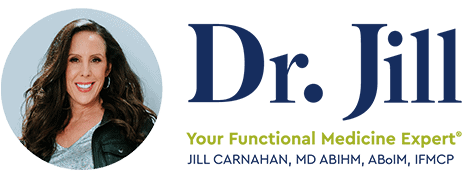



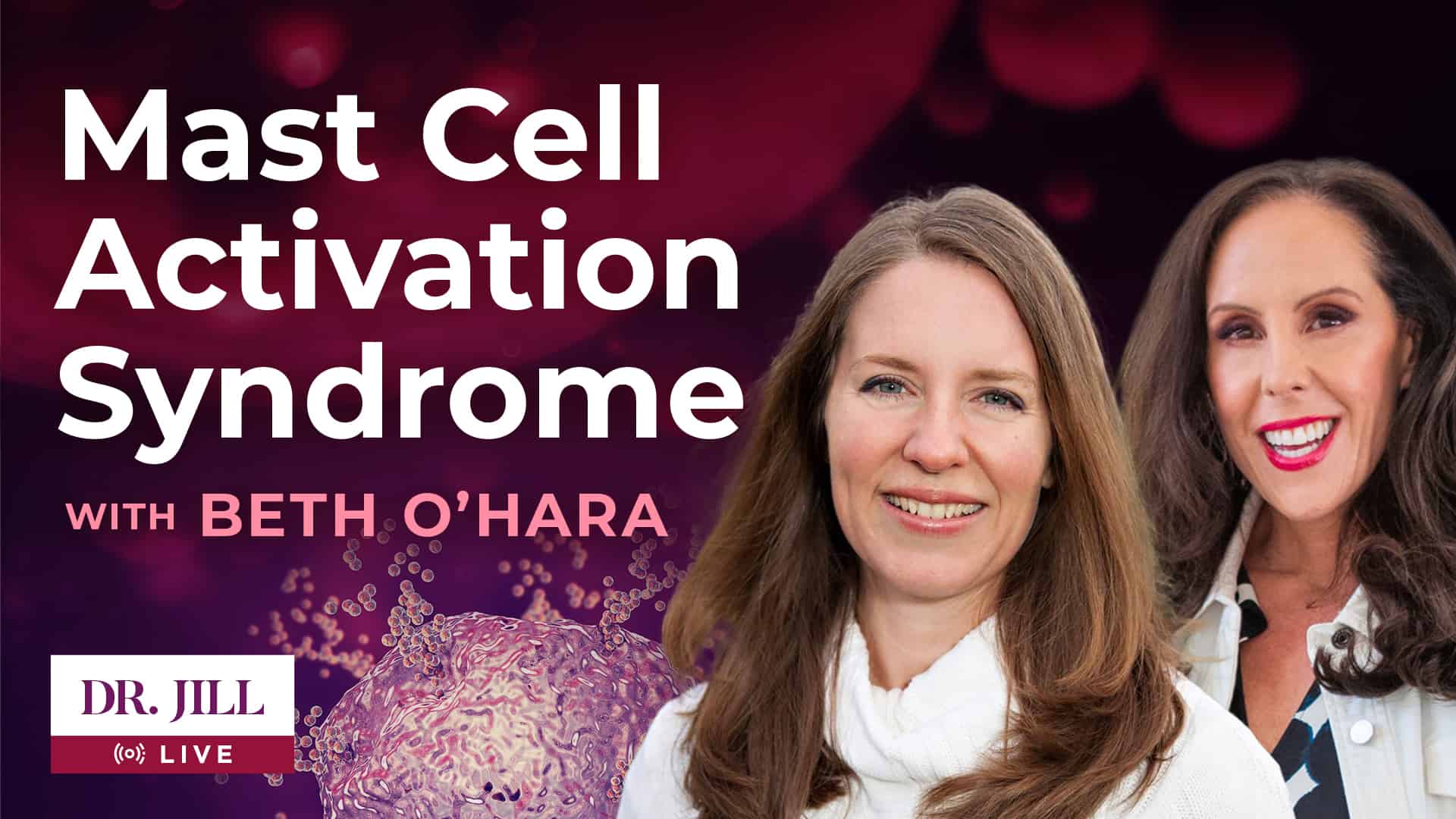
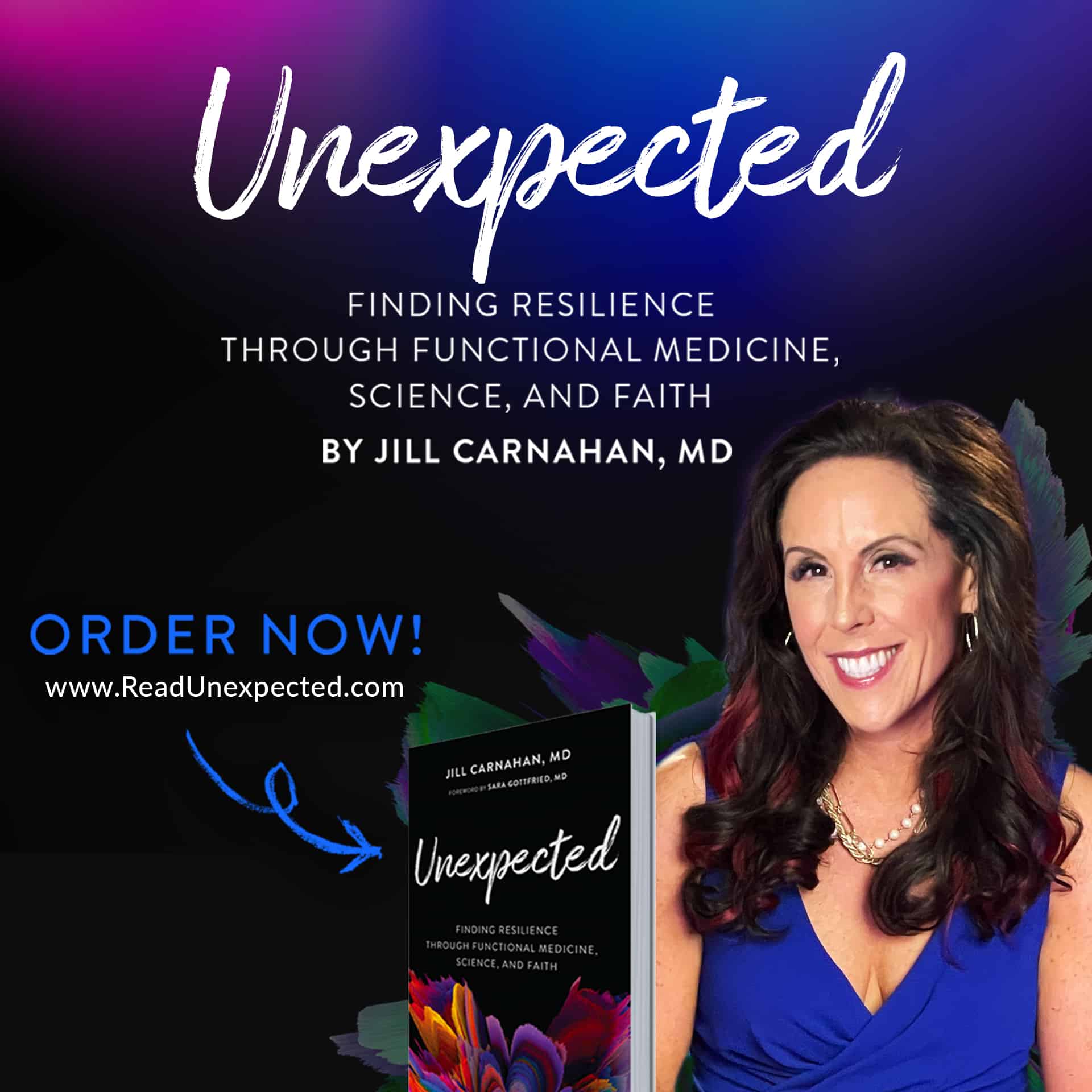


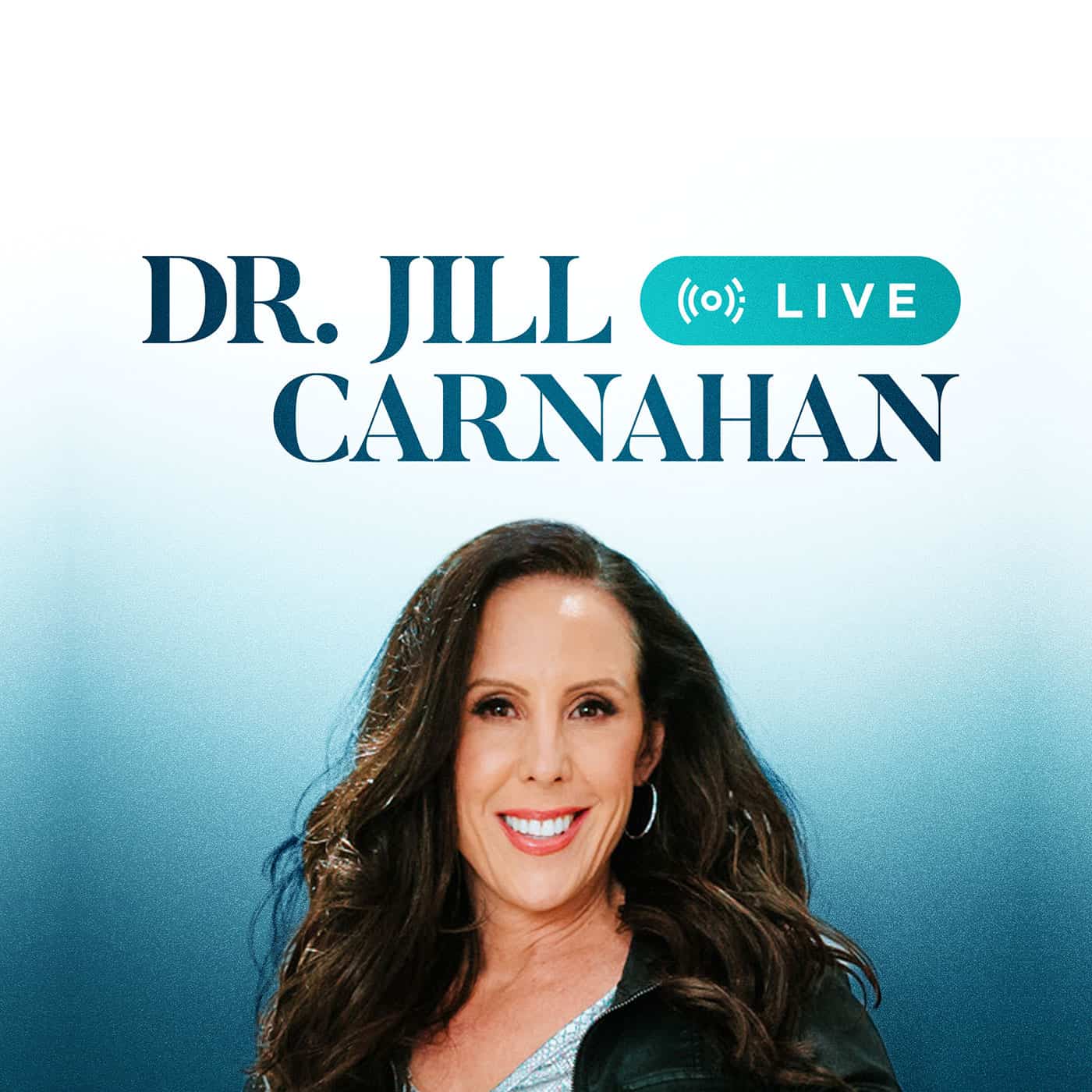
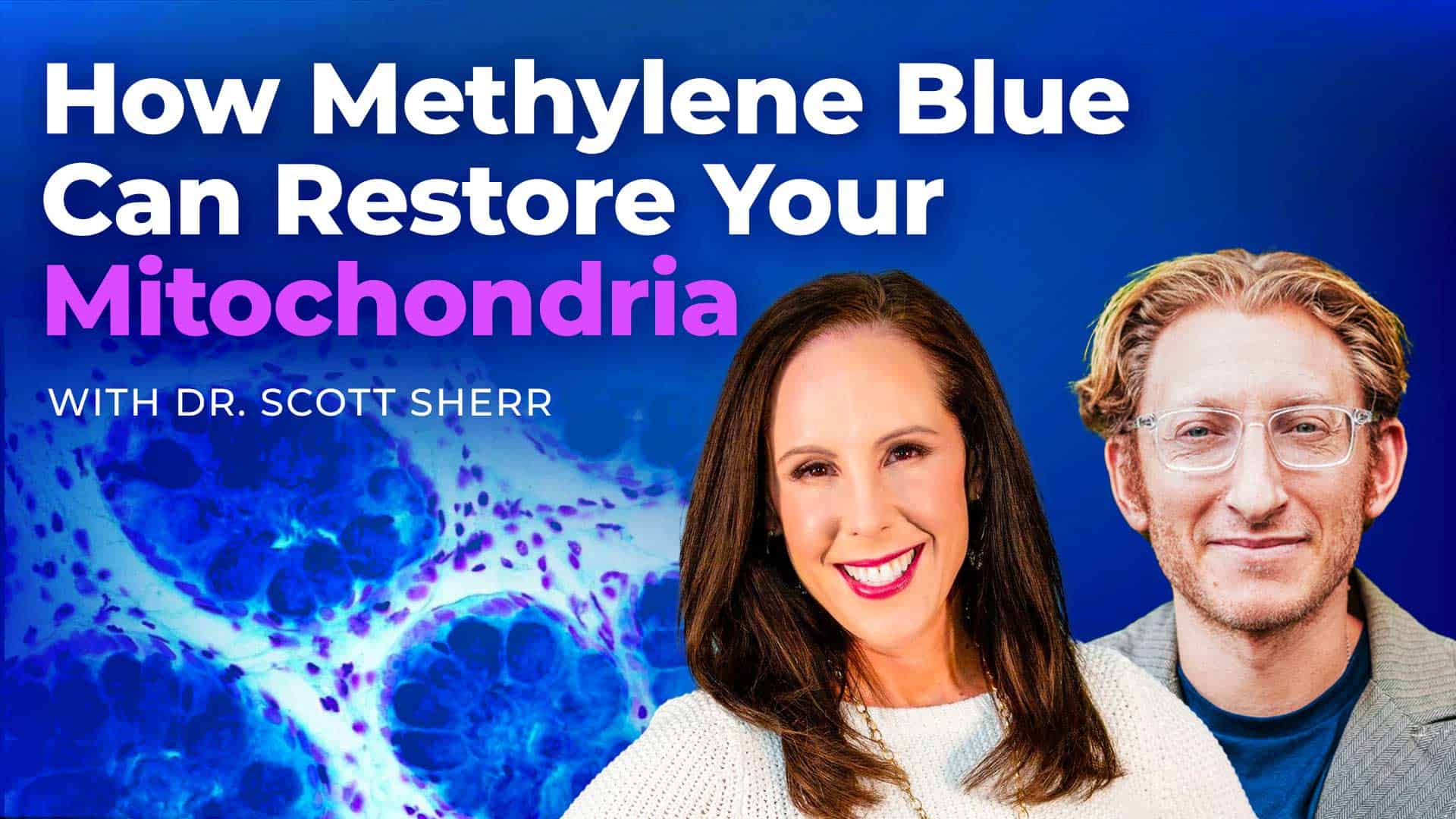
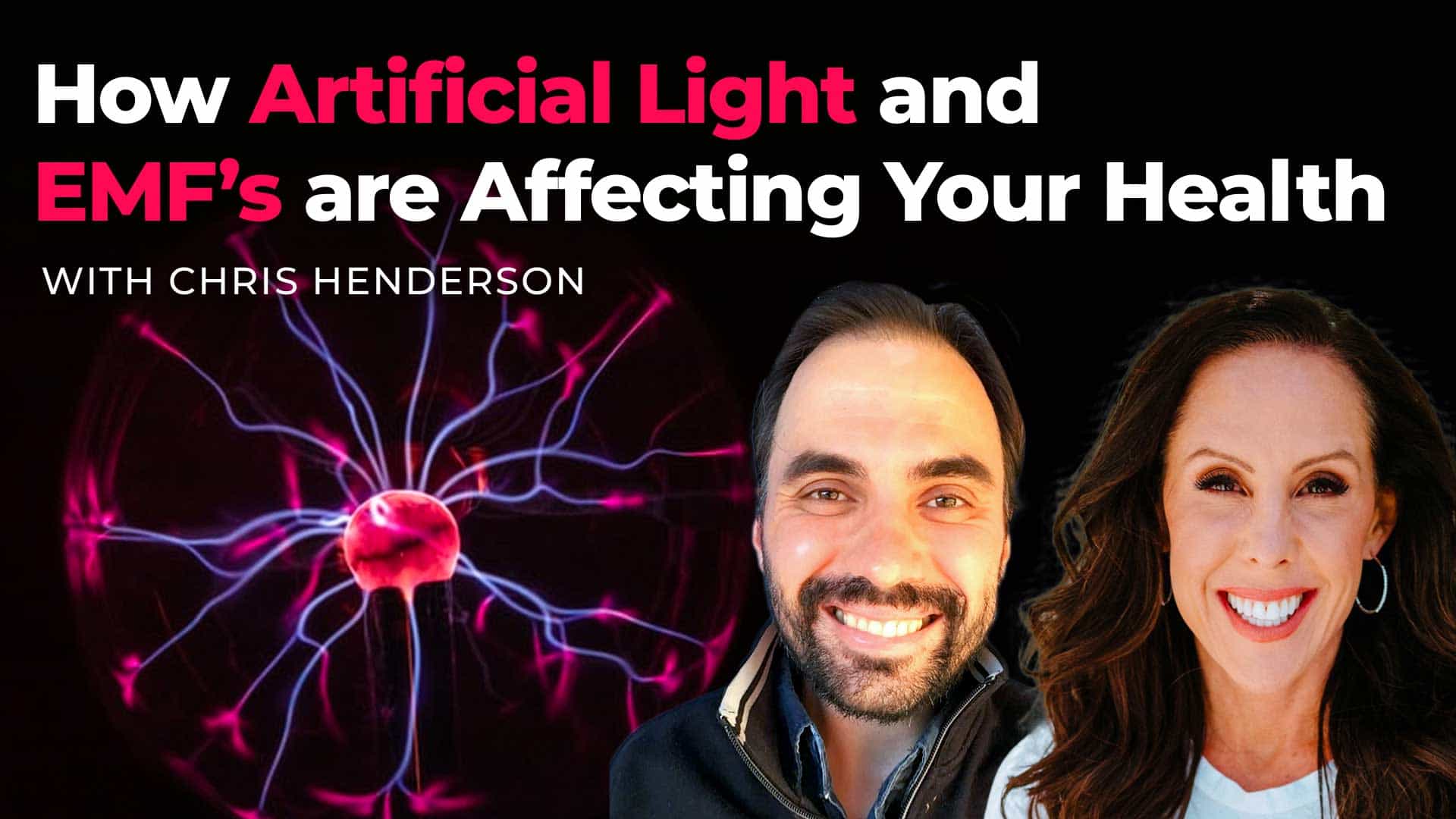
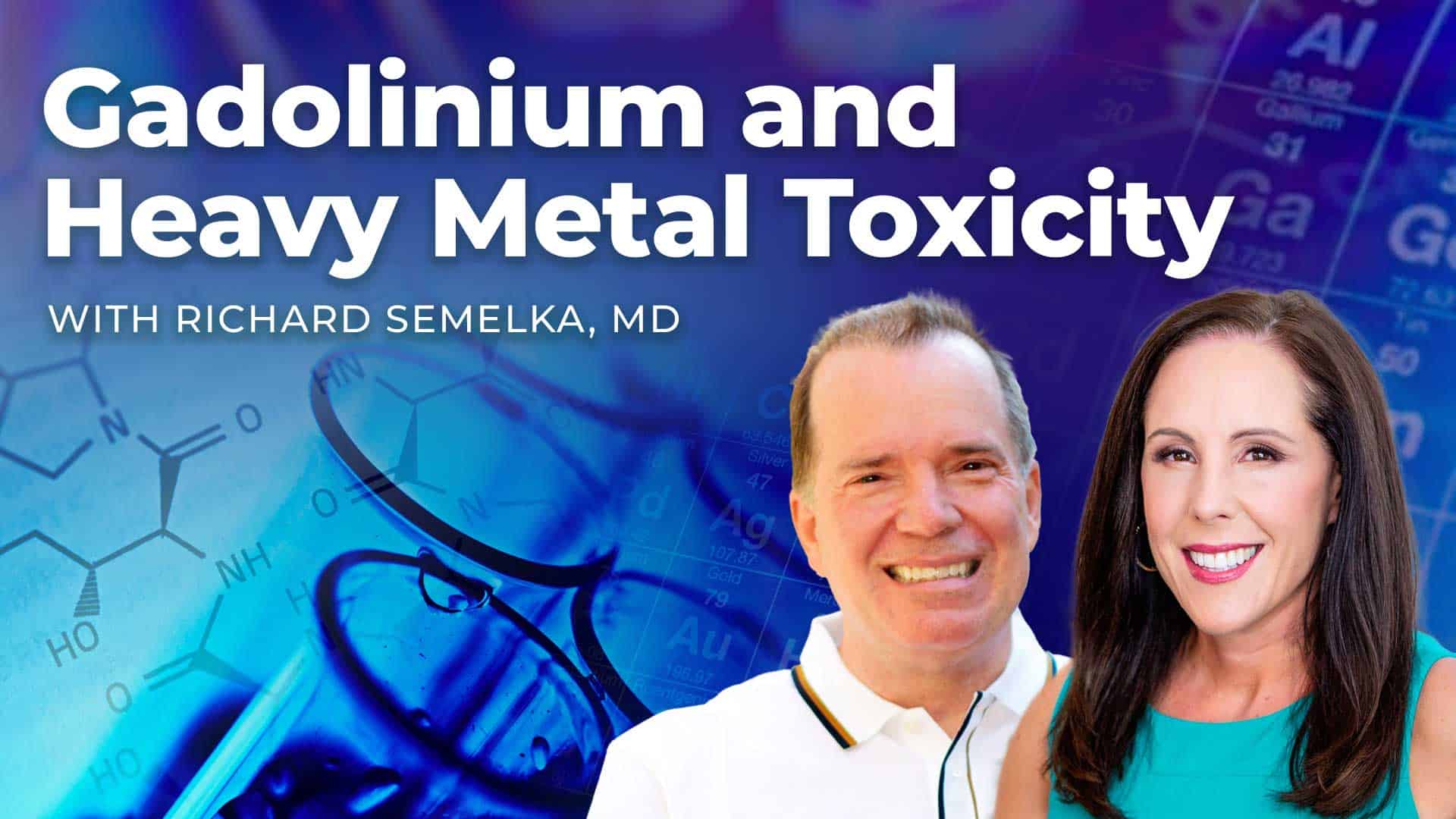
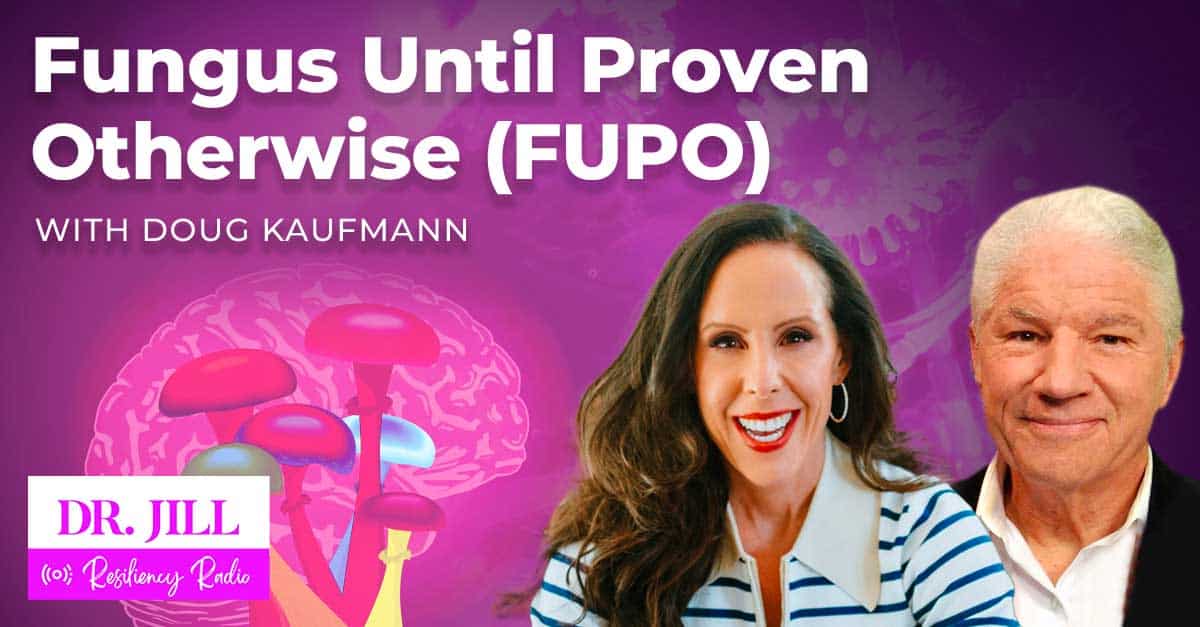



1 Comment
I’ve been diagnosed with Canada and HFMD, sores and rings and bumps on my fingers, unresponsive to Diflucan for a month po 150 mg Q week for a month. So I’m at mid diagnosis healthcare worker 38 years license RN and I need help, treatment guidance. I may have a chronic mold issue in my condo from a water leak from top to bottom from my shower that leaks when I L when I take a shower too long to the drywall of my kitchen ceiling. I’ve had a MVA in chronic pain from deserve this disease I have mood and memory issues. Two questions before I have my house ripped up is there a blood test that can diagnose fungo level in my system and is there one for limes disease as well as some of the satellite bumps on my thumb look like a bite mark it as it they just don’t heal. There’s no itching but I take Zyrtec daily and I’ve had multiple radio frequency ablation in my cervical area. But the eczema in my ear ears still itch and I can feel that. So I dismissed the fungal thinking I had a topic dermatitis but both have a chino which I don’t . Now I’m thinking I have chronic fungal mold toxicity by dermatologist in area after asking the MA is there a test she said no. I live in Fresno California which is not exactly Mayo clinic respectively. I’ve actually drive from Saint Paul Minnesota in was hired years ago over the phone and I turned it down. But that was the pass I am in a lot of discomfort and pain and I’m sure I have microbio him issues big-time with a poor diet. I would appreciate if you could reach out to me. I have Blue Cross anthem. PPO. We just have one functional medicine doctor in I don’t think he has the background to treat all this, I could be wrong. But first things first I want to find a reasonable company that will gouge me thousands to check my home and clean it if it needs it. Almost be cheaper to move. Second and most important starting with the basics can I get these two conditions tested. Thank you very much for your time. John McDonnell . My email address is John McDonnell 701@gmail.com. Phone number 559-367-1490. And I believe you’re out of Colorado even if I had to do a zoom call I wanna know if insurance will cover it since we’re kind of limited here we’re still a small town despite half 1 million. Please do not post my Hyppa rights Are Paramont of course. Looking forward to hearing from your call I think you could really help me out and I can send you pictures of my hands. Thank you I don’t want to lose my job 35 years at a level one trauma center.
Share: